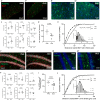Aging and senescent fates of oligodendrocyte precursor cells in the mouse brain
- PMID: 39438481
- PMCID: PMC11496697
- DOI: 10.1038/s41514-024-00176-y
Aging and senescent fates of oligodendrocyte precursor cells in the mouse brain
Abstract
Age-related changes in oligodendrocyte precursor cells (OPCs) contribute to white matter dysfunction. In aged mice, we hypothesized that myelin-dense fimbria OPCs possess niche-specific properties, compared to hippocampal OPCs. Aged fimbria OPCs were fewer, larger, and localized to neighboring microglia. We identified age-increased p16/Cdkn2a-expressing OPCs enriched for senescence-related pathways and distinct senescence signatures between hippocampus and fimbria. Aged brain OPC populations differ in microenvironment properties and responses to senescence-directed intervention.
© 2024. The Author(s).
Conflict of interest statement
M.J.S., C.M.C., and Mayo Clinic have intellectual property related to senescence research. Research in the M.J.S. laboratory is reviewed by the Mayo Clinic Conflict of Interest Review Board and conducted in compliance with Mayo Clinic Conflict of Interest policies. All other authors declare no conflicts.
Figures



References
Grants and funding
- K99 AG058798/AG/NIA NIH HHS/United States
- CA275669/U.S. Department of Health & Human Services | National Institutes of Health (NIH)
- R00 AG058798/AG/NIA NIH HHS/United States
- AG058798/U.S. Department of Health & Human Services | National Institutes of Health (NIH)
- UH3 CA275669/CA/NCI NIH HHS/United States
LinkOut - more resources
Full Text Sources
Miscellaneous

